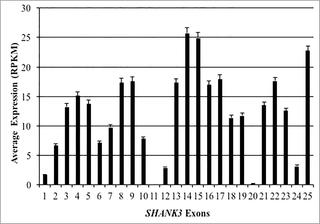Our official English website, www.x-mol.net, welcomes your feedback! (Note: you will need to create a separate account there.)
Functional genomics analysis of Phelan-McDermid syndrome 22q13 region during human neurodevelopment.
PLOS ONE ( IF 3.7 ) Pub Date : 2019-03-15 , DOI: 10.1371/journal.pone.0213921 Catherine A Ziats 1 , Luke P Grosvenor 2, 3 , Sara M Sarasua 4 , Audrey E Thurm 2 , Susan E Swedo 2 , Ahmed Mahfouz 5 , Owen M Rennert 1, 2 , Mark N Ziats 1, 6
PLOS ONE ( IF 3.7 ) Pub Date : 2019-03-15 , DOI: 10.1371/journal.pone.0213921 Catherine A Ziats 1 , Luke P Grosvenor 2, 3 , Sara M Sarasua 4 , Audrey E Thurm 2 , Susan E Swedo 2 , Ahmed Mahfouz 5 , Owen M Rennert 1, 2 , Mark N Ziats 1, 6
Affiliation

|
Phelan-McDermid syndrome (PMS) is a neurodevelopmental disorder characterized by varying degrees of intellectual disability, severely delayed language development and specific facial features, and is caused by a deletion within chromosome 22q13.3. SHANK3, which is located at the terminal end of this region, has been repeatedly implicated in other neurodevelopmental disorders and deletion of this gene specifically is thought to cause much of the neurologic symptoms characteristic of PMS. However, it is still unclear to what extent SHANK3 deletions contribute to the PMS phenotype, and what other genes nearby are causal to the neurologic disease. In an effort to better understand the functional landscape of the PMS region during normal neurodevelopment, we assessed RNA-sequencing (RNA-seq) expression data collected from post-mortem brain tissue from developmentally normal subjects over the course of prenatal to adolescent age and analyzed expression changes of 65 genes on 22q13. We found that the majority of genes within this region were expressed in the brain, with ATNX10, MLC1, MAPK8IP2, and SULT4A1 having the highest overall expression. Analysis of the temporal profiles of the highest expressed genes revealed a trend towards peak expression during the early post-natal period, followed by a drop in expression later in development. Spatial analysis revealed significant region specific differences in the expression of SHANK3, MAPK8IP2, and SULT4A1. Region specific expression over time revealed a consistently unique gene expression profile within the cerebellum, providing evidence for a distinct developmental program within this region. Exon-specific expression of SHANK3 showed higher expression within exons contributing to known brain specific functional isoforms. Overall, we provide an updated roadmap of the PMS region, implicating several genes and time periods as important during neurodevelopment, with the hope that this information can help us better understand the phenotypic heterogeneity of PMS.
中文翻译:

人类神经发育过程中Phelan-McDermid综合征22q13区的功能基因组学分析。
Phelan-McDermid综合征(PMS)是一种神经发育障碍,其特征是智力残疾程度不同,语言发育和特定面部特征严重延迟,并且是由22q13.3号染色体内的缺失引起的。位于该区域末端的SHANK3已反复牵涉到其他神经发育障碍,并且该基因的缺失特别被认为会引起PMS的许多神经系统症状。但是,尚不清楚SHANK3缺失在多大程度上有助于PMS表型,附近还有哪些其他基因与神经系统疾病有关。为了更好地了解正常神经发育过程中PMS区域的功能格局,我们评估了从发育正常受试者的死后脑组织收集的RNA测序(RNA-seq)表达数据,这些数据来自产前至青春期,并分析了22q13上65个基因的表达变化。我们发现该区域内的大多数基因在大脑中表达,其中ATNX10,MLC1,MAPK8IP2和SULT4A1的整体表达最高。分析表达最高的基因的时间分布,发现在出生后早期趋于峰值表达,随后在发育后期表达下降。空间分析表明,SHANK3,MAPK8IP2和SULT4A1的表达存在明显的区域特异性差异。随着时间的流逝,区域特异性表达揭示了小脑内一致的独特基因表达谱,为该地区独特的发展计划提供证据。SHANK3的外显子特异性表达显示出有助于已知脑特异性功能同工型的外显子内的更高表达。总体而言,我们提供了PMS区域的更新路线图,暗示了在神经发育过程中重要的几个基因和时间段,希望此信息可以帮助我们更好地了解PMS的表型异质性。
更新日期:2019-03-17
中文翻译:

人类神经发育过程中Phelan-McDermid综合征22q13区的功能基因组学分析。
Phelan-McDermid综合征(PMS)是一种神经发育障碍,其特征是智力残疾程度不同,语言发育和特定面部特征严重延迟,并且是由22q13.3号染色体内的缺失引起的。位于该区域末端的SHANK3已反复牵涉到其他神经发育障碍,并且该基因的缺失特别被认为会引起PMS的许多神经系统症状。但是,尚不清楚SHANK3缺失在多大程度上有助于PMS表型,附近还有哪些其他基因与神经系统疾病有关。为了更好地了解正常神经发育过程中PMS区域的功能格局,我们评估了从发育正常受试者的死后脑组织收集的RNA测序(RNA-seq)表达数据,这些数据来自产前至青春期,并分析了22q13上65个基因的表达变化。我们发现该区域内的大多数基因在大脑中表达,其中ATNX10,MLC1,MAPK8IP2和SULT4A1的整体表达最高。分析表达最高的基因的时间分布,发现在出生后早期趋于峰值表达,随后在发育后期表达下降。空间分析表明,SHANK3,MAPK8IP2和SULT4A1的表达存在明显的区域特异性差异。随着时间的流逝,区域特异性表达揭示了小脑内一致的独特基因表达谱,为该地区独特的发展计划提供证据。SHANK3的外显子特异性表达显示出有助于已知脑特异性功能同工型的外显子内的更高表达。总体而言,我们提供了PMS区域的更新路线图,暗示了在神经发育过程中重要的几个基因和时间段,希望此信息可以帮助我们更好地了解PMS的表型异质性。



























 京公网安备 11010802027423号
京公网安备 11010802027423号